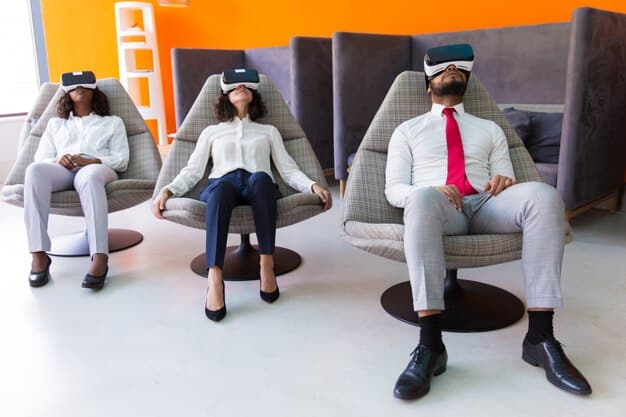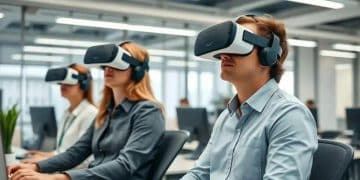VR Onboarding Checklist: Is Your US Company Ready?

Is your US company considering virtual reality (VR) for employee onboarding? This 5-step readiness checklist assesses your current infrastructure, content creation capabilities, employee training needs, budget allocation, and evaluation metrics to determine if your organization is prepared to successfully implement a VR-based onboarding program.
Considering a VR-based onboarding experience for your new hires? The following Is Your US Company Ready for VR-Based Employee Onboarding? A 5-Step Readiness Checklist will help you navigate the crucial steps toward successful implementation and engagement.
Assessing Your Infrastructure for VR Onboarding
Before diving headfirst into VR onboarding, it’s essential to evaluate the current state of your company’s technological infrastructure. This includes assessing hardware, software, and network capabilities to ensure a smooth and effective VR experience.
Hardware Requirements and Compatibility
One of the first considerations is the hardware needed to support VR onboarding. Ensure that you have enough VR headsets, controllers, and compatible computers to accommodate all new hires participating in the program.
Software and Platform Integration
Another critical aspect is the software and platform integration required for VR onboarding. This includes the VR platform itself, content creation tools, and integration with existing HR and training systems.
- Headset Quantity and Quality: Verify you have sufficient headsets in good working order.
- Network Bandwidth: Ensure your network can handle multiple VR sessions without lag.
- IT Support Availability: Confirm your IT team can troubleshoot VR-related issues promptly.
- Device Compatibility: Match VR software with compatible computers to avoid glitches.
In conclusion, a thorough assessment of your infrastructure is vital to ensure it meets the demands of VR onboarding. Identifying and addressing gaps in hardware, software, and network capabilities early on can prevent frustrations and delays later in the process.

Evaluating Your Content Creation Capabilities
Creating compelling and effective VR onboarding content is crucial for engaging new hires and delivering valuable training. It’s important to assess your organization’s current content creation capabilities, including the availability of resources, expertise, and tools.
In-House vs. Outsourced Content Creation
Decide if you have the necessary talent and resources in-house to create VR onboarding content or if you need to outsource the creation to a specialized VR development company. Each approach has its pros and cons in terms of cost, control, and expertise.
Content Relevance and Engagement
Ensure that the VR onboarding content is relevant, engaging, and aligned with your company’s culture, values, and learning objectives. Consider incorporating interactive elements, gamification, and storytelling techniques to enhance the learning experience.
- Storytelling: Incorporate narratives to make onboarding more memorable and engaging.
- Interactive Elements: Design tasks within the VR environment to ensure hands-on learning.
- Realistic Simulations: Replicate real-world scenarios to prepare employees for their roles.
- Company Culture Integration: Weave your firm’s values and practices into the VR experience.
To summarize, the effectiveness of VR onboarding largely depends on the quality and relevance of the content. By evaluating whether to develop content in-house or outsource, and ensuring it remains engaging and linked to company values, you can set your onboarding process up for success.
Analyzing Employee Training Needs for VR
Before implementing VR onboarding, it’s important to understand the specific training needs of your employees. This analysis will help you tailor the VR content and experiences to address the most relevant and impactful learning objectives.
Identifying Key Training Objectives
Determine the key knowledge, skills, and behaviors that new hires need to acquire during the onboarding process. This may include topics such as company policies, product knowledge, customer service techniques, and safety procedures.
VR as a Training Solution
Examine if VR can address training needs more effectively than traditional methods. Areas where VR shines include immersive experiences, hands-on simulations, and risk-free environments for practicing complex skills.
- Skill Gaps: Use VR to address identified shortcomings in employees’ skill sets.
- Compliance Training: VR can make mandatory training more immersive and engaging.
- Software Proficiency: Provide virtual environments for practicing software applications.
Effectively using VR for employee training relies on carefully considering what your team needs to learn and how this medium can help them learn better than other options. Identifying training objectives and examining VR’s unique benefits allows you to create an impactful and tailored onboarding experience.

Budget Allocation for Virtual Reality Onboarding
Implementing a VR-based employee onboarding program involves significant financial investment. It’s essential to allocate a sufficient budget to cover the costs of hardware, software, content creation, and ongoing maintenance for effective implementation.
Cost Components of VR Implementation
Break down the various cost components of VR onboarding, including VR headsets, controllers, software licenses, content development, IT support, and training of onboarding staff. Consider the long-term ROI of VR onboarding in terms of improved employee engagement, retention, and productivity.
ROI of VR Investments
Evaluate the potential return on investment (ROI) of VR onboarding by comparing it to traditional onboarding methods. Calculate cost savings from reduced physical materials, travel expenses, and faster time-to-productivity for new hires.
- Hardware Costs: Factor in the cost of headsets, controllers, and compatible computers.
- Content Creation: Budget for either in-house VR developers or outsourcing content.
- Maintenance and Support: Provide a budget for ongoing maintenance and technical support.
Effectively managing and understanding your budget directly influences the sustainability and impact of your VR onboarding strategy. By carefully identifying costs and evaluating ROI, you can guarantee your organization’s long-term success with VR onboarding.
Evolving Your Metrics to Evaluate the VR Onboarding Program
Measuring the effectiveness of your VR onboarding program is critical for ongoing improvement and optimization. By tracking key metrics and gathering feedback from new hires, you can identify areas of strength, address weaknesses, and maximize the ROI of your VR investment.
Tracking Key Performance Indicators
Establish key performance indicators (KPIs) to track the success of your VR onboarding program. These may include metrics such as employee engagement, knowledge retention, time-to-productivity, and employee satisfaction. Align your metrics strategy with VR’s unique ability to create data-rich insights. Use VR analytics to pinpoint where employees interact most, where they struggle, and what content resonates best.
Gathering Employee Feedback
Implement methods for gathering feedback from new hires who participate in the VR onboarding program. This may include surveys, focus groups, and one-on-one interviews. Make sure to solicit honest opinions and suggestions for improvement.
- Engagement Tracking: Monitor how long employees spend in VR modules.
- Knowledge Retention: Test knowledge gained via VR onboarding.
- Feedback Surveys: Gather opinions about the VR experience.
- Performance Metrics: Track time-to-productivity and employee satisfaction.
Regular evaluation is more than just a review; it’s a crucial part of evolving and optimizing the VR onboarding process. By tracking key metrics and gathering feedback from new hires, companies can ensure that their VR investment continues to deliver value, driving both employee and company success.
| Key Aspect | Brief Description |
|---|---|
| ⚙️ Infrastructure | Assess hardware, software, and network capabilities. |
| 📝 Content | Create engaging, relevant VR onboarding content. |
| 🎯 Training Needs | Identify knowledge and skills required for new hires. |
| 💰 Budget | Allocate funds for hardware, software, and support. |
Frequently Asked Questions (FAQ)
▼
You will need VR headsets, controllers, and compatible computers to run the VR software. Ensure you have enough equipment to accommodate all new hires.
▼
This depends on your internal resources and expertise. Outsourcing can provide specialized skills, while in-house creation offers more control over content.
▼
Identify core knowledge, skills, and behaviors new hires need to acquire. Focus on areas where VR provides unique benefits, such as immersive simulations.
▼
Budget for hardware, software, content creation, IT support, and training for onboarding staff. Evaluate the ROI by comparing it to traditional methods.
▼
Track employee engagement, knowledge retention, time-to-productivity, and satisfaction. Also, gather feedback from new hires through surveys and interviews.
Conclusion
By systematically addressing each step in this checklist, US companies can accurately gauge their readiness for implementing a VR-based employee onboarding program. From assessing infrastructure and content creation capabilities to analyzing training needs, allocating a robust budget, and refining evaluation metrics, a prepared organization will create a far more impactful, engaging, and efficient onboarding process that sets new hires up for success from day one.





